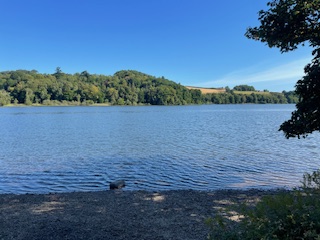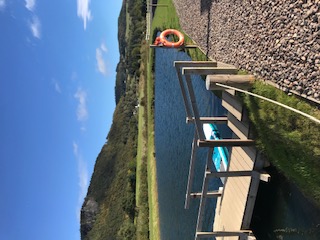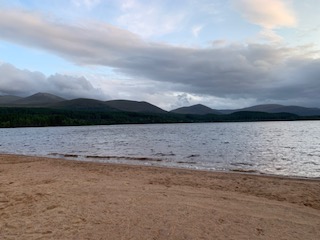Top Tips For Open Water Swimming
- ellawebley
- May 27, 2024
- 5 min read

With the warmer weather taking it's time to arrive it can be easy to put off getting back - or even introducing yourself - to open water swimming.
But if you've signed up for a race that has an open water swim then, I'm afraid to tell you, no amount of pool swimming is going to prepare you for that.
Swimming in a loch or lake or the sea is uniquely different from swimming in the (hopefully) pristine clean pool where the only dangerous thing in there is the discarded plaster from the guy in front of you or the dirty looks and mutterings from the breast strokers not wanting to get their hair wet. And whilst a death stare from Gloria and her buddies might put you off your stroke a little, it's nothing compared to a 'what the hell was that that just touched my foot' moment or a rugby player sized body trying to swim over the top of you can do.
Now don't get me wrong, swimming in the open water is absolutely amazing. It's incredibly good for you both physically and mentally, and you will feel a real sense of achievement from doing it - as well as looking like a bad ass to all those who don't even like getting their toes wet. It does however, come with it's very real dangers, and there's no sugar coating that - and if I am honest, nor do I want to. But rather than list all the ways you could die from open water swimming, here's my top 5 tips on how to prepare for open water.
What To Wear
I highly recommend a wet suit - a swimming one, not a surfing or paddle boarding one. Not only does it keep you warmer, it provides some buoyancy. Now it's going to feel tight, it's designed that way. And it's going to be a pain to get on, but it's worth it. If you own it, you can usually cut the arms and legs down if you need to and a little off the neck if it's causing you discomfort. Remember though, if you really don't feel good in it then it's probably a wrong fit (so don't cut it unless you are sure).
Swimming costume or tri-suit underneath. I've never gone naked but I don't think I would recommend that. Especially when it comes to taking the thing off.
Neoprene hat if you struggle with cold or a swim cap. As brightly coloured as you care - the easier it is to see the easier it is for someone to spot you, and you want that in open water.
Goggles - mirrored are a good choice as, even though we rarely see him, the sun is still there, and if he decides to blind you with his ray of sunshine you won't have a clue where you are going.
Tow float - again brightly coloured is good, and you get ones you can put your car keys and phone in (not that you should be planning on making calls mid swim but should there be an emergency this could be handy). A tow float is great for when you want to take a little breather. You can grab on to it, settle your breath, adjust your goggles, and get going again.
Gloves and booties are optional.
Where To Swim
If you've never been open water before then check your local area to see if there are any monitored sessions close by. Many lochs/lakes that have companies operating water sports also offer monitored swim sessions.
Check social media pages for any organised groups - open water swimming is on the rise and there are many early morning 'dookers' who may not necessarily be there to train for a triathlon but they will know that loch/lake like the back of their hand.
Use a search engine such as google - and then get as much information as you can from different sources about any place you are thinking of going.
Safety First
Yeah ok, it probably comes across as 'boring' when you want to talk about safety but seriously, you could die, so pay attention.
Never swim or dook (dip) alone. Even the strongest and most experienced of outdoor swimmers don't tend to swim alone. At the very least having someone on shore watching is a great idea. And, as with all outdoor training, let someone else know where you are going, how long you expect to be, and when you expect to be back.
Check the weather - if it's high winds, thunderstorms or below freezing then don't go in. Currents and tides are not to be messed with and neither is hypothermia. Thor is not your friend if you are in the water either.
For your first few swims/dooks take it slow, acclimatise. It's going to be cold and a bit of a shock to your system. You might even struggle to get your face in. Start with going deep enough to either squat down or even sit and open the neck of your wetsuit to let some water in. Then let more in. Blow some bubbles and gradually get more and more of your face in the water. When you're ready, swim a little, but stop when you need to catch your breath.
After Your Swim

Have your gear ready to get changed into. You will most likely need -
A towel and/or dry robe to shield you whilst you change.
Either a small towel or mat to stand on whilst you get changed.
Warm, easy to get on clothing. Ditch those leggings, lycra is not your friend here. Jogging bottoms are great and a loose jumper (obviously your underwear too).
Flask with a hot drink if it's quite cold. This will help heat you up from the inside.
A big bag for all your gear - an IKEA bag is perfect for this.
Small snack, just in case.
Respect The Area
If there is a sign up saying 'No swimming' then don't swim, I mean come on. There could be hidden dangers, there could be obvious dangers, it could be just the local land owner sick of people being on his land - you don't know. Just go somewhere else.
Leave no trace. We have all heard this saying and there is no reason not to stick to it. If you eat a snack loch side then make sure you take the wrapper home. If you have a bottle of water to drink for after, take it home. It's not rocket science.
Local wildlife - this is their home, leave them alone. Don't go charging in if there is a group of ducklings right in front of you or any other bird for that matter (including swans - scary things swans). Leave all nests well alone and try to keep any noise down - save your energy for actually swimming.
I would encourage anybody to give open water a try. Even just a little dook here and there. And I would especially encourage anyone planning on racing in an open water event to get into the open water sooner rather than later.








Comments